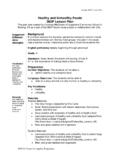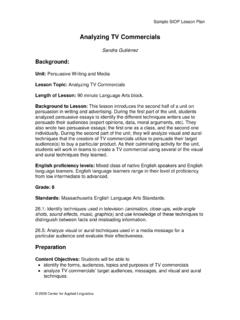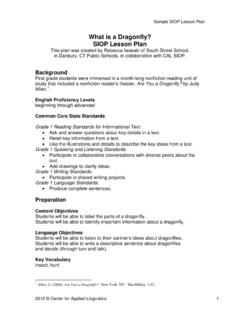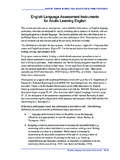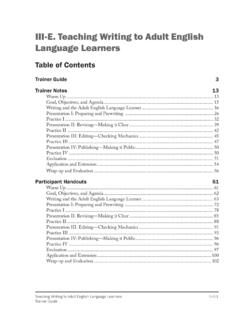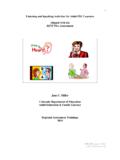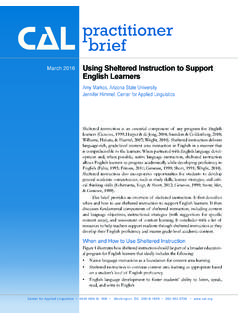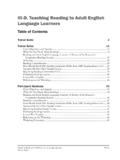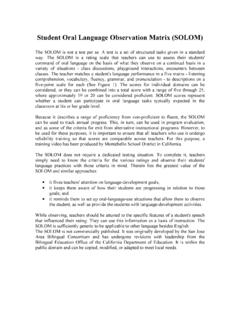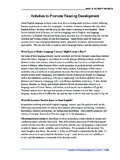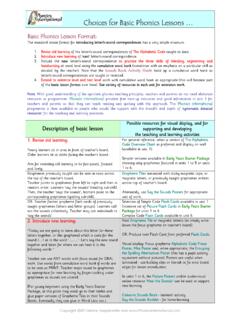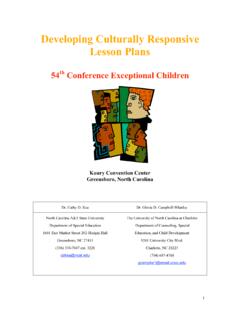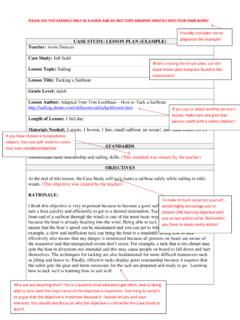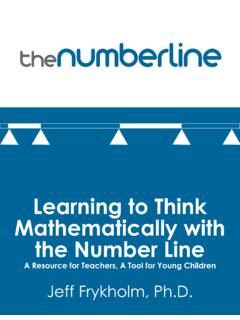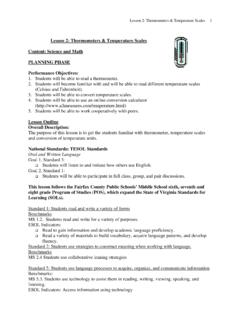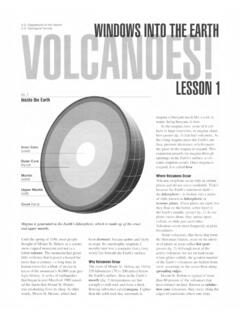Transcription of III-C. Effective Lesson Planning for Adult English ...
1 III-C. Effective Lesson Planning for Adult English Language Learners Table of Contents Trainer Guide 3. Part 1 8. Part 2 21. Trainer Notes, Part 1 35. Goal, Objectives, and 35. 37. Part I: Background Information: Effective Lesson 38. Comparative Lesson Plan 43. Identifying Meaningful ESL Lesson 44. Identifying Stages of a Lesson Matching 47. Lesson Activity Types Information Gap .. 48. Model Lesson 52. Model Lesson Plan Questions: Answer 54. Lesson Planning 55. Application 59. Participant Handouts, Part 1 65. Goal, Objectives, and 65. 67. Part I: Background Information: Effective Lesson 68. Identifying Meaningful ESL Lesson 73. Lesson Activity Types Information 75. Model Lesson 76. Model Lesson Plan 77. Lesson Planning 78. Comparative Lesson Plan 81. Application 82.
2 Workshop 87. Trainer Notes, Part 2 89. Goal, Objectives, and 89. Yes/No Bingo!.. 90. 92. Background Part 2: Effective Lesson Planning .. 93. Directions for Jigsaw Reading .. 99. Effective Lesson Planning for Adult English Language Learners III-C-1. Trainer Guide The CAELA Guide for Adult ESL Trainers Varying Activities and Grouping 99. Model Lesson Plan: Beginning 100. Multilevel Lesson 101. Multilevel Lesson 103. Comprehension 106. Giving 107. 108. Pacing and 109. Beginning Low Lesson 110. Teacher Talk and Learner 111. 112. Lesson Planning 113. Application Lesson Planning 115. Lesson 116. Class Action 118. Participant Handouts, Part 2 119. Goal, Objectives, and Part 2: Background Information: Effective Lesson 121. Directions for Jigsaw 126. Varying Activities and Grouping 127.
3 Model Lesson Plan: Beginning 128. Multilevel Lesson 129. Comprehension 133. Giving 134. 135. Pacing and 136. Beginning Low Lesson 137. Teacher Talk and Learner 138. 139. Lesson Planning 140. Application Lesson Planning 142. Lesson 143. Class 144. Action 145. Workshop 146. III-C-2 Effective Lesson Planning for Adult English Language Learners Trainer Guide The CAELA Guide for Adult ESL Trainers Effective Lesson Planning for Adult English Language Learners This workshop module contains detailed instructions and all of the materials necessary to con- duct two training sessions on Effective Lesson Planning for Adult English language learners. The module has five components: 44 Trainer Guide 44 Trainer Notes, Part 1. 44 Trainer Notes, Part 2. 44 Participant Handouts, Part 1.
4 44 Participant Handouts, Part 2. The Trainer Guide is the trainer's script for the training session. It contains step-by-step instruc- tions for presenting the workshop. It begins with an introduction that states the rationale and purpose of the workshop. It also gives the goal and objectives of the workshop, the workshop agenda, an overview of workshop sections with the amount of time to be spent on each section, trainer preparation instructions, and materials needed. The introduction is followed by detailed sequential instructions for conducting each section of the workshop. The introduction to each section states the purpose of the activities and the timing of that sec- tion. This is followed by a two-column table with instructions for each activity in the first column (Action) and the materials needed in the second column (Materials).
5 Hard copies of all of the materials needed (with the exception of non-CAELA publications) are provided in the Trainer Notes or the Participant Handouts. Materials are listed by title followed by the page number on which it can be found and TN (indicating it can be found in the Trainer Notes) or PH (indicat- ing it can be found in the Participant Handouts). Ordering information for non-CAELA publi- cations is given in the workshop introduction. Materials that need to be made into transparencies for use with an overhead projector or PowerPoint slides are marked Transparency or PowerPoint Slide. You will need to prepare them before the training session. The Trainer Notes accompanies the script of the Trainer Guide. It includes copies of all of the participant handouts, answer keys to participant activities, transparencies or PowerPoint slides to be made, and other supplemental handouts if appropriate.
6 The contents of the Trainer Notes are organized in the order they are needed in the session, and the place they will be used is indicated in the Materials column in this Trainer Guide. When participants are to use materials from Par- ticipant Handouts, the page numbers of the handouts that correspond to a section of the Trainer Notes are indicated. The Participant Handouts contains all of the information and activity sheets that participants need to participate in the session and will take with them when they leave. The contents are also orga- nized in the order they will be used in the session. Make a copy of the handouts for each participant. Effective Lesson Planning for Adult English Language Learners III-C-3. Trainer Guide The CAELA Guide for Adult ESL Trainers Effective Lesson Planning for Adult English Language Learners Introduction to the module: Planning a language learning Lesson is different from Planning other types of lessons.
7 This workshop helps participants develop lessons for language learning and introduces them to the stages of a language learning Lesson . An Effective Lesson plan starts with a goal and objectives that meet the needs of the learners and includes activities that lead, step by step, to the completion of the goal. The purpose of this workshop is to help instructors of Adult students of English as a second language (ESL) understand the elements of an Effective language learning Lesson Planning for their learners. The workshop activities are based on a variety of well- regarded sources in the field of Lesson Planning for language lessons. (See Resources at the end of this overview.) The workshop can be tailored for instructors of all levels of Adult ESL learners and includes a section on working with multilevel classes.
8 We recommend that this workshop be held in two sessions, so we have divided the workshop into Part 1 and Part 2. Each session takes approximately 4 hours. Ideally, the second part of the workshop should take place 2 3 weeks (and no later than 4 weeks) after the first part so partici- pants have the opportunity to write a language learning Lesson plan and implement it in their own classroom between sessions. However, both parts may also be done in the same day, making the total training time 8 hours, excluding time for breaks and lunch. If the workshop is done in 1 day (8 hours) with inexperienced teachers, it is best to do the train- ing as it is written because one presentation/activity leads naturally to the next. However, if the workshop is done in two 4-hour sessions, as recommended above, the second session should be modified to allow participants time to discuss the Lesson plans that they developed and delivered in their classrooms between the two sessions.
9 Also, if the workshop is attended by experienced teachers, please note the comments in the Trainer Guide for doing the workshop with experi- enced teachers. The trainer can use the knowledge that experienced teachers bring to the work- shop and build on their classroom experience. Target audience for this workshop: New and experienced teachers, tutors, and classroom aides Goal of the workshop: To develop skills in Planning Effective lessons based on promising practices III-C-4 Effective Lesson Planning for Adult English Language Learners Trainer Guide The CAELA Guide for Adult ESL Trainers Workshop objectives for participants: At the end of this workshop, participants will be able to do the following: Part I Part II. Recognize the principles underlying Lesson Recognize the role that varied activities, Planning for language lessons grouping strategies, and other aspects of Identify Lesson objectives classroom practice have in Effective language Lesson Planning Identify the stages of a language Lesson Recognize the principles underlying Lesson Select appropriate activities for each stage of Planning for multilevel classes the Lesson Identify reflective teaching strategies Analyze a Lesson in a textbook and identify its stages and activities Develop activities for each stage of a Lesson and use them to write a Lesson Length of workshop: 4 hours The workshop components for Part 1 are as follows: Part 1.
10 Introductions and Warm-Up 30 minutes Part 2. Presentation: Background information, Lesson 1 hour, 40 minutes objectives and enabling skills, stages of a Lesson Part 3. Practice: Activity types and components of a 50 minutes Lesson plan Part 4. Application (in workshop): Analyze a textbook 40 minutes Lesson and use textbook activities to develop a Lesson plan Part 5. Wrap-Up and Evaluation 10 minutes Total projected length of workshop 240 minutes* ( 4 hours). *Note: There is a 10-minute break approximately halfway through the workshop, the exact time for the break to be selected by the trainer. The workshop components for Part 2 are as follows: Part 1. Introduction and Warm-Up 20 minutes Part 2. Presentation: Background information 30 minutes Part 3. Practice: Stages of a Lesson and activities for 2 hours, 5 minutes each stage Part 4.
